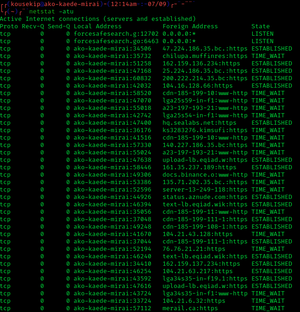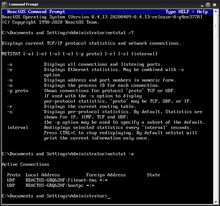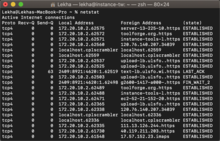what should you enter at the command prompt to display both listening and non-listening sockets
 The netstat command | |
| Programmer(due south) | Diverse open up-source and commercial developers |
|---|---|
| Initial release | 1983 (1983) |
| Operating system | Unix, Unix-similar, Plan 9, Inferno, Os/2, Microsoft Windows, ReactOS |
| Platform | Cross-platform |
| Type | Command |
| License | Bone/ii, Windows: Proprietary commercial software net-tools, ReactOS: GPLv2 |
In computing, netstat ( netpiece of work statistics) is a control-line network utility that displays network connections for Transmission Control Protocol (both incoming and outgoing), routing tables, and a number of network interface (network interface controller or software-defined network interface) and network protocol statistics. Information technology is available on Unix, Plan ix, Inferno, and Unix-like operating systems including macOS, Linux, Solaris and BSD. Information technology is likewise available on IBM OS/ii and on Microsoft Windows NT-based operating systems including Windows XP, Windows Vista, Windows 7, Windows viii and Windows 10.
It is used for finding problems in the network and to determine the amount of traffic on the network as a performance measurement.[1] On Linux this program is more often than not obsolete, although nevertheless included in many distributions.
On Linux, netstat (part of "cyberspace-tools") is superseded by ss (office of iproute2). The replacement for netstat -r is ip road, the replacement for netstat -i is ip -s link, and the replacement for netstat -g is ip maddr, all of which are recommended instead.[2] [3] [4] [five]
Statistics provided [edit]

Netstat provides statistics for the post-obit:
- Proto – The proper name of the protocol (TCP or UDP).
- Local Accost – The IP address of the local figurer and the port number being used. The name of the local computer that corresponds to the IP address and the name of the port is shown unless the -n parameter is specified. An asterisk (*) is shown for the host if the server is listening on all interfaces. If the port is not notwithstanding established, the port number is shown equally an asterisk.
- Foreign Address – The IP address and port number of the remote estimator to which the socket is connected. The names that corresponds to the IP address and the port are shown unless the -due north parameter is specified. If the port is not yet established, the port number is shown as an asterisk (*).
- State – Indicates the state of a TCP connection. The possible states are as follows: CLOSE_WAIT, Airtight, ESTABLISHED, FIN_WAIT_1, FIN_WAIT_2, LAST_ACK, LISTEN, SYN_RECEIVED, SYN_SEND, and TIME_WAIT. For more data about the states of a TCP connection, see RFC 793.
Parameters [edit]
Parameters used with this command must be prefixed with a hyphen (-) rather than a slash (/). Some parameters are not supported on all platforms.
| Name | Clarification | Windows | ReactOS | macOS | BSD | NetBSD | FreeBSD | Linux | Solaris | OS/2 |
|---|---|---|---|---|---|---|---|---|---|---|
| -a | Displays all active connections and the TCP and UDP ports on which the figurer is listening. | Yep | Yes | Yeah | ||||||
| -b | Displays the binary (executable) plan's name involved in creating each connection or listening port. (Windows XP, Windows Server 2003 and newer Windows operating systems; not Microsoft Windows 2000 or older). | Yep | No | No | ||||||
| -b | Causes -i to report the full number of bytes of traffic. | No | Yes | Yep | No | |||||
| -e | Displays ethernet statistics, such as the number of bytes and packets sent and received. This parameter can exist combined with -s. | Yep | Yeah | No | ||||||
| -f | Displays fully qualified domain names <FQDN> for foreign addresses (simply available on Windows Vista and newer operating systems). | Aye | No | No | ||||||
| -f Accost Family unit | Limits display to a item socket address family, unix, inet, inet6 | No | Yes | No | ||||||
| -g | Displays multicast group membership information for both IPv4 and IPv6 (may just be available on newer operating systems) | No | No | Yes | ||||||
| -i | Displays network interfaces and their statistics | No | No | Yes | ||||||
| -m | Displays the memory statistics for the networking code (STREAMS statistics on Solaris). | No | No | |||||||
| -n | Displays active TCP connections, however, addresses and port numbers are expressed numerically and no attempt is fabricated to determine names. | Yeah | Yeah | Aye | ||||||
| -o | Displays active TCP connections and includes the process id (PID) for each connexion. You can find the application based on the PID in the Processes tab in Windows Job Managing director. This parameter can be combined with -a, -due north, and -p. This parameter is available on Microsoft Windows XP, Windows Server 2003, and Windows 2000 if a hotfix is applied.[6] | Yes | No | No | ||||||
| -p protocol | Shows connections for the protocol specified by protocol. In this case, protocol tin be tcp, udp, tcpv6, or udpv6. If this parameter is used with -southward to display statistics by protocol, protocol can be tcp, udp, icmp, ip, tcpv6, udpv6, icmpv6, or ipv6. | Yes | Yep | Yes | ||||||
| -p | Bear witness which processes are using which sockets (similar to -b under Windows) (y'all must be root to exercise this) | No | No | Aye | ||||||
| -P protocol | Shows connections for the protocol specified by protocol. In this case, protocol tin be ip, ipv6, icmp, icmpv6, igmp, udp, tcp, or rawip. | No | No | Yes | ||||||
| -r | Displays the contents of the IP routing table. (This is equivalent to the route print command under Windows.) | Yeah | Aye | Yes | Yes | |||||
| -southward | Displays due southtatistics by protocol. By default, statistics are shown for the TCP, UDP, ICMP, and IP protocols. If the IPv6 protocol for Windows XP is installed, statistics are shown for the TCP over IPv6, UDP over IPv6, ICMPv6, and IPv6 protocols. The -p parameter can exist used to specify a set of protocols. | Yes | Yes | Yes | ||||||
| -t | Display but TCP connections. | No | Yes | Yep | ||||||
| -u | Brandish simply UDP connections. | No | No | Aye | Yes | |||||
| -W | Display wide output - doesn't truncate hostnames or IPv6 addresses | No | No | Yep | No | |||||
| -x | Displays NetworkDirect connections, listeners, and shared endpoints. | Aye | ||||||||
| -y | Displays the TCP connectedness template for all connections.Cannot exist combined with the other options. | Aye | ||||||||
| -five | When used in conjunction with -b it will display the sequence of components involved in creating the connection or listening port for all executables. | Aye | No | No | ||||||
| Interval | Redisplays the selected information every Interval seconds. Press CTRL+C to stop the redisplay. If this parameter is omitted, netstat prints the selected data just once. | Yeah | Yes | No | ||||||
| -h | Displays help at the control prompt. | Yeah | No | Yes | Yes | Yes | Yeah | Yes | Aye | No |
| -? | Displays aid at the control prompt. | Yes | No | No | No | No | No | No | No | Yep |
| /? | Displays assistance at the control prompt. | Yes | Yes | No | No | No | No | No | No | No |
Examples [edit]
Cross platform [edit]
On macOS, BSD systems, Linux distributions, and Microsoft Windows:
To display the southwardtatistics for simply the TCP or UDP protocols, type 1 of the following commands:
netstat -sp tcp
netstat -sp udp
Unix-like [edit]
On Unix-similar systems:
To brandish all ports open by a process with id pid:
netstat -aop | grep "pid"
To continuously brandish open TCP and UDP connections numerically and also which program is using them on Linux:
netstat -nutpacw
Windows [edit]
On Microsoft Windows:
To display active TCP connections and the process IDs every 5 seconds, type the following command (works on NT based systems only, or Windows 2000 with hotfix):
netstat -o five
To display active TCP connections and the process IDs using northwardumerical form, blazon the following command (works on NT based systems only, or Windows 2000 with hotfix):
netstat -no
*zip [edit]
| Command | Explanation |
|---|---|
netstat -a | Shows all sockets , both listening and non-listening, all protocols like TCP, UDP etc. |
netstat -at | Shows only TCP connections (-au shows only UDP connections) |
netstat -pismire | Shows all TCP connections with no DNS resolution (testify IP addresses instead). |
netstat -al | Shows only listening sockets. |
netstat -aep | Too show PID and to which programme each socket belongs, e adds extra info like the user. Run as root to run across all PIDs. |
netstat -due south > file2.txt | Shows network statistics. |
netstat -r | Shows kernel routing information. This is the same output as road -e. |
netstat -i | Displays a table of all network interfaces. Add together -e to get output similar to ifconfig. |
netstat -ct | Displays TCP connections continuously. |
netstat -1000 | Display multicast group membership data for IPv4 and IPv6. |
netstat -lntu | Display all services listening for TCP and UDP, all free open ports on the local auto. |
netstat -atnp | grep ESTA | Displays all currently "established" TCP connections. |
Wildcards [edit]
Netstat uses a asterisk * as a wildcard which means "whatever". An case would be
Example output:
....Local Address Foreign Address State ... *:smtp *:* LISTEN Under "Local Address" *, in *:smtp, means the procedure is listening on all of the network interfaces the machine has for the port mapped every bit smtp (see /etc/services for service resolution). This can also exist shown as 0.0.0.0. The commencement *, in *:*, means connections tin can come up from any IP address, and the second *, in *:*, means the connexion can originate from any port on the remote machine.
Caveats [edit]
Some versions of netstat lack explicit field delimiters in their printf-generated output, leading to numeric fields running together and thus corrupting the output information.
[edit]

The macOS netstat control
Nether Linux, raw data can ofttimes be obtained from the /proc/cyberspace/dev to work effectually the printf output corruption arising in netstat'southward network interface statistics summary, netstat -i, until such fourth dimension as the problem is corrected.[ citation needed ]
On the Windows platform, netstat information can be retrieved by calling the GetTcpTable and GetUdpTable functions in the IP Helper API, or IPHLPAPI.DLL. Data returned includes local and remote IP addresses, local and remote ports, and (for GetTcpTable) TCP status codes. In addition to the control-line netstat.exe tool that ships with Windows, GUI-based netstat programs are available.
On the Windows platform, this control is bachelor just if the Net Protocol (TCP/IP) protocol is installed every bit a component in the properties of a network adapter in Network Connections.
On the Windows platform running Remote Desktop Services (formerly Terminal Services) it will just testify connections for the electric current user, non for the whole computer.
On macOS, the /System/Library/CoreServices/Applications binder (or /Applications/Utilities in Bone X Mountain Lion and before) contains a network GUI utility called Network Utility, the Netstat tab of which runs the netstat control and displays its output in the tab.
Encounter also [edit]
- ss, a Linux utility to investigate sockets from iproute2 meant to replace netstat
- lsof -i
- bmon
References [edit]
- ^ "IBM Systems Data Center". ibm.com. 8 May 2007.
- ^ "internet-tools". linuxfoundation.org.
- ^ "Curvation Linux". archlinux.org. 8 June 2011.
- ^ "Deprecated Linux networking commands and their replacements". Doug Vitale Tech Blog. 21 December 2011.
- ^ "netstat man page (notes section)". Retrieved 2 August 2014.
This program is obsolete. Replacement for netstat is ss. Replacement for netstat -r is ip route. Replacement for netstat -i is ip -s link. Replacement for netstat -grand is ip maddr.
- ^ "The netstat command can now display procedure IDs that correspond to active TCP or UDP connections in Windows 2000". Archived from the original on 24 Baronial 2007.
Further reading [edit]
- Dyson, Peter (1995). Mastering Bone/2 Warp. Sybex. ISBN978-0782116632.
- Stanek, William R. (2008). Windows Command-Line Administrator's Pocket Consultant, second Edition. Microsoft Printing. ISBN978-0735622623.
External links [edit]
- – Linux Programmer's Transmission – Administration and Privileged Commands
- – FreeBSD General Commands Transmission
- – Solaris 10 System Administration Commands Reference Manual
- – Inferno General commands Manual
- Microsoft TechNet: Netstat – documentation for the Windows netstat.exe control-line program
- internet-tools project page on SourceForge
- Netstat Command: WindowsCMD.com
Source: https://en.wikipedia.org/wiki/Netstat
0 Response to "what should you enter at the command prompt to display both listening and non-listening sockets"
Post a Comment